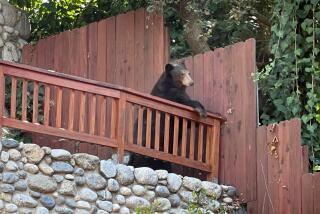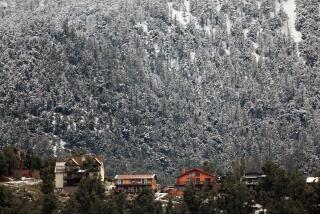Rescued ‘Dancing Bears’ of Greece Learn the Rhythms of Nature
- Share via
NYMPHAIO, Greece — Tethered by a chain to a ring through its nose, a bear clad in a frilly skirt and matching bonnet hops forlornly from leg to leg to the beat of a drum.
Thus the “dancing bear” performed for generations in Greece, around the Balkans and across Russia. It was a life of captivity and constant pain. A metal ring pierced the bear’s nose or lips to subdue its aggression and force it to prance.
Now the curtain has come down on the show in Greece. The practice apparently has been stamped out. Furthermore, a pioneering sanctuary has opened to give the once-captive bears a chance to taste the freedom they never had.
They learn, in a sense, how to be bears--how to forage for food, climb trees, even how to hibernate.
The goal is to instill the skills and instincts to help the animal “become a normal bear,” says Lazaros Georgiadis, a biologist and scientific manager of the Arcturos bear facility in northern Greece.
The training of dancing bears is “essentially torture,” Georgiadis says.
First, the cub’s canine teeth are smashed, usually by a large hammer, depriving the bear of one of its main defenses. Its nose or lips are then pierced to make way for a metal ring attached to a chain.
Because these are the most sensitive areas of the animal, even the slightest tug on the chain ensures full submission.
The cubs are forced to walk on burning embers or a hot sheet of metal, and hop from one hind leg to the other to escape the pain, Georgiadis says.
During this, the trainer beats a drum rhythmically. The process is repeated until the bear learns to connect the drumbeat to the pain and instinctively begins to dance as soon as it hears the first beats.
Duke and Koukla are two of the Arcturos residents to have made the transition from the streets to the forest enclosure.
A large brown bear, Duke rises from his den dug into the roots of a beech tree on the misty slopes of Mt. Verno. He strolls over to a pool where rainwater has collected from the previous night and takes a bath.
A dancing bear from a young age, Duke was sold as a pet at the age of 3. For the next two years, he lived tied up in a backyard. His owner gave him to the sanctuary in 1994.
Koukla, an 11-year-old female, slowly scratches her back on the bark of a tree overlooking the valley before bounding off into the dense brush.
The Greek Forestry Department confiscated Koukla, a dancing bear, from her owner about five years ago. After a short stay at a wild animal veterinary station on the island of Aegina, she became the Arcturos sanctuary’s first resident.
The refuge is a short walk from Nymphaio, a picturesque stone village about 100 miles northwest of Salonica. The animals are allowed to roam a 5-acre patch of beech forest enclosed by an electric fence. A small hut provides shelter and a place for hibernation in the winter.
The area is only a fraction of the territory usually claimed by wild bears, which can roam over an area of up to 60 square miles. But it is enough to help the bears regain some of their natural instincts and behavior patterns.
“These animals will never be released back into the wild,” Georgiadis says. Since dancing bears are captured while still very young, they are never given the chance to learn basic survival skills from their parents. Their missing teeth, too, would put them at a severe disadvantage.
Now an endangered species, the brown bear roamed almost the whole of Europe until the 15th century. But their numbers and habitat have shrunk drastically in the last two centuries. About 35,000 remain in Europe, with all but several thousand in Russia.
According to recent studies, Greece’s bear population numbers from 110 to 130, mostly in the mountains near Greece’s borders with Albania and Macedonia.
Besides the forest sanctuary, the 5-year-old Arcturos facility also has a veterinary station where new arrivals are treated for the effects of their performing lifestyles.
Ten bears now live in the protection center, five in the forest sanctuary and the rest in the veterinary station. Most are former dancing bears, but a few were rescued from zoos.
One, 3-year-old Tassoula, was an orphan found by shepherds.
Dancing-bear troupes have come under extreme pressure from Greek authorities for years. All performing bears are immediately confiscated and Greeks appear to have abandoned the practice, according to the agriculture ministry. The last two cubs brought to Arcturos--Yiorgakis and Irini--were imported from Albania.
The center also has turned its attention to rescuing bears from zoos, which are “still of a Victorian type [in Greece],” Georgiadis says.
“Confined spaces, lack of medical care, random diet . . . nothing that takes into consideration the animals’ quality of life,” he added.
Once a dancing bear reaches the veterinary station, the metal ring is surgically removed. Peter Kertesz, a dentist from Britain, inserts fillings or removes badly decayed teeth.
After the bears’ physical health is restored, the Arcturos staff puts tree trunks, car tires, leaves and twigs in the spacious cages to keep the animals occupied.
“Their food is hidden in these so that the bears have to search, so that it isn’t all ready for them,” Georgiadis said.
While attracted to both meat and plants, brown bears tend to adapt their eating habits to whatever is most abundant in their environment. Greece’s population is almost exclusively herbivore.
Because the animals in Arcturos have led most of their lives in captivity, they are unable to hibernate and must be taught how to listen to their instincts.
So from March to August, they are given about 9 to 13 pounds of food daily. This is increased from August to November, when the bears consume about 40 to 44 pounds daily. Food is gradually reduced throughout December, and stops completely at the end of the month.
Fifteen days later, the bears fall into a light sleep until mid-March. During hibernation, they can lose up to a third of their weight, which ranges from 220 to 550 pounds for males and 175 to 300 for females.
To the joy of the Arcturos staff, Duke, the 8-year-old former dancer, instinctively dug his own den in which to hibernate last year.
“It is one of the few cases when a captive bear has done something like this,” Georgiadis said proudly.
The center recently held a conference in Nymphaio with delegates from Albania, Bulgaria and Macedonia to decide on a common action plan for the species’ protection.
Although bear numbers in the wild may gradually be dwindling in the Balkans, all female bears living in the Arcturos protection center receive a hormone implant every three years to prevent them from reproducing.
“We don’t want to create a new generation of captive bears,” Georgiadis says. “That is not our aim.”
(BEGIN TEXT OF INFOBOX / INFOGRAPHIC)
Bear Territory
The habitat of the brown bear originally stretched from the tundra of Alaska to the steppes of Asia and across most of North America and Europe, said biologist Yiorgos Mertzanis, head scientist of the Arcturos bear sanctuary. About 35,000 brown bears remain in three main pockets:
* Scandinavia and Russia--by far the largest habitat.
* The Caucasus.
* The Balkans and the Carpathian Mountains, which span the Czech Republic, Slovakia, Ukraine and much of Romania.
Few bears exist elsewhere in Europe: about 10 in France, about 50 in Italy and another 50 in Spain.
The brown bear is believed to have vanished from Britain in the 10th century and later from Germany, Switzerland and Austria.
In the United States, there are about 600 brown bears, mainly in national parks such as Yellowstone, and they are protected as an endangered species. Others are in the Kodiak Islands of Alaska.
Canada has 3,000 to 4,000 brown bears, also protected by law.
Associated Press
More to Read
Sign up for Essential California
The most important California stories and recommendations in your inbox every morning.
You may occasionally receive promotional content from the Los Angeles Times.













